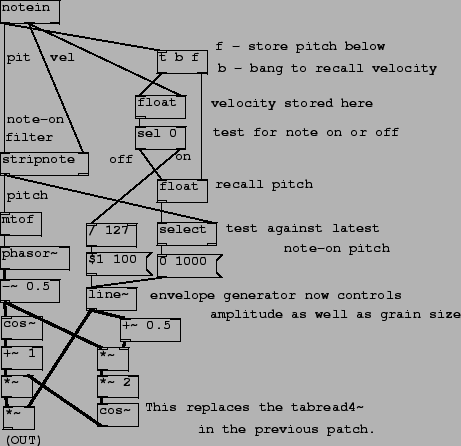 |
Patch C10.monophonic.synth.pd (figure 3.16) also implements a monophonic, note-oriented synthesizer, but in this case oriented toward MIDI controllability. Here the tasks of envelope generation and sequencing pitches is handled using control streams instead of audio signals. Several new control objects are needed for this example.
![]() :
MIDI note input. Three outlets present the pitch, velocity, and channel of
incoming MIDI note-on and note-off events (with note-off events appearing as
velocity-zero note-on events.) The outlets appear in Pd's customary
right-to-left order.
:
MIDI note input. Three outlets present the pitch, velocity, and channel of
incoming MIDI note-on and note-off events (with note-off events appearing as
velocity-zero note-on events.) The outlets appear in Pd's customary
right-to-left order.
![]() :
filter out note-off messages. This passes
(pitch, velocity) pairs through whenever the velocity is nonzero, dropping
the others. Unlike
:
filter out note-off messages. This passes
(pitch, velocity) pairs through whenever the velocity is nonzero, dropping
the others. Unlike
![]() ,
,
![]() does not
input or output actual MIDI messages.
does not
input or output actual MIDI messages.
![]() ,
,
![]() :
copy a message to outlets in right to left order, with type conversion. The
creation arguments (``b" and ``f" in this example) specify two outlets, one
giving
:
copy a message to outlets in right to left order, with type conversion. The
creation arguments (``b" and ``f" in this example) specify two outlets, one
giving bang messages, the other float (i.e., numbers). One outlet
is created for each creation argument. Other types are ``l" for list,
``s" for symbol, and ``a" to output anything (i.e., a copy of the input
message, whatever it is). The incoming message is converted (as
faithfully as possible) into whatever format is specified by the creation
argument. Although the outputs appear in Pd's standard right-to-left order,
no time elapses between each of the outputs; they are deterministically
ordered and yet instantaneous.
The patch's control objects feed frequencies to the
![]() object
whenever a note-on message is received. Controlling the amplitude (via the
object
whenever a note-on message is received. Controlling the amplitude (via the
![]() object) is more difficult. When a note-on message is
received, the ``sel 0" object outputs the velocity at right (because the
input failed to match 0); this is divided by the maximum MIDI velocity of 127
and packed into a message for
object) is more difficult. When a note-on message is
received, the ``sel 0" object outputs the velocity at right (because the
input failed to match 0); this is divided by the maximum MIDI velocity of 127
and packed into a message for
![]() with a time of 100 msec.
with a time of 100 msec.
However, when a note-off is received, it is only appropriate to stop the sound if the note-off pitch actually matches the pitch the instrument is playing. For example, suppose the messages received are ``60 127", ``72 127", ``60 0", and ``72 0". When the note-on at pitch 72 arrives the pitch should change to 72, and then the ``60 0" message should be ignored, with the note playing until the ``72 0" message.
To accomplish this, first we store the velocity in the upper
![]() object. Second, when the pitch arrives, it too is stored (the lower
object. Second, when the pitch arrives, it too is stored (the lower
![]() object) and then the velocity is tested against zero (the
object) and then the velocity is tested against zero (the
bang outlet of ``t b f" recalls the velocity which is sent to ``sel 0").
If this is zero, the second step is to recall the pitch and test it (the
![]() object) against the most recently received note-on pitch.
Only if
these are equal (so that
object) against the most recently received note-on pitch.
Only if
these are equal (so that bang appears at the left-hand-side outlet of
select) does the message 0 1000 go to the
line~ object.